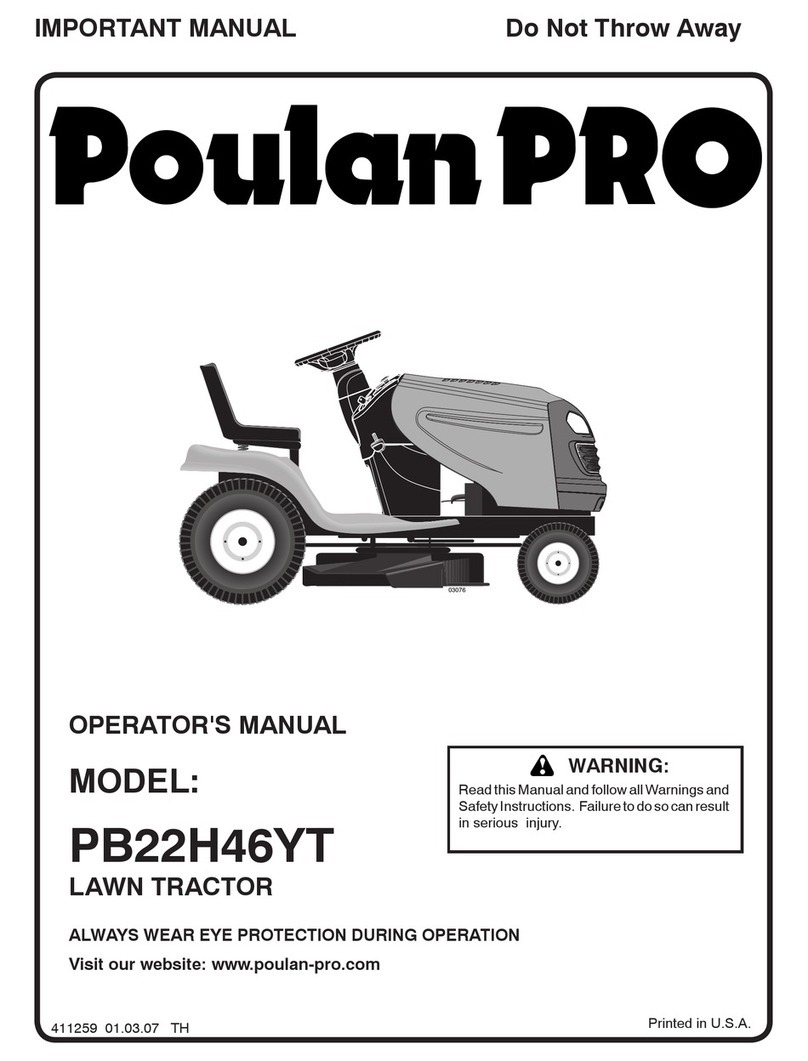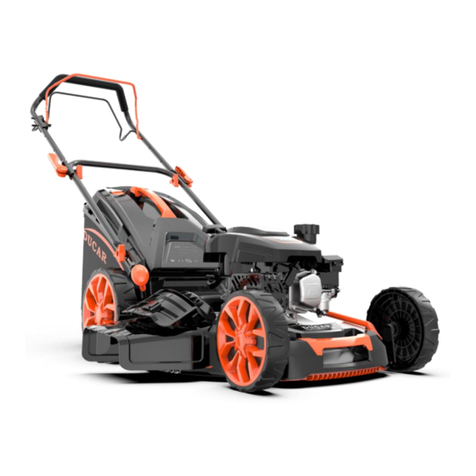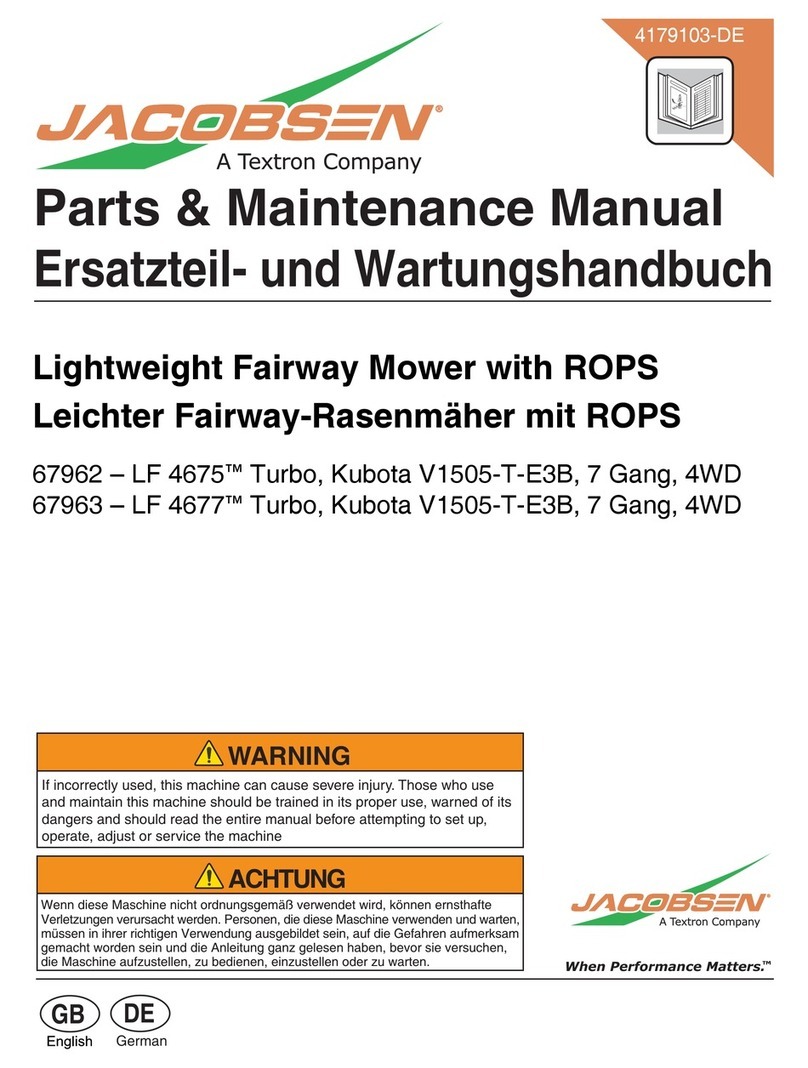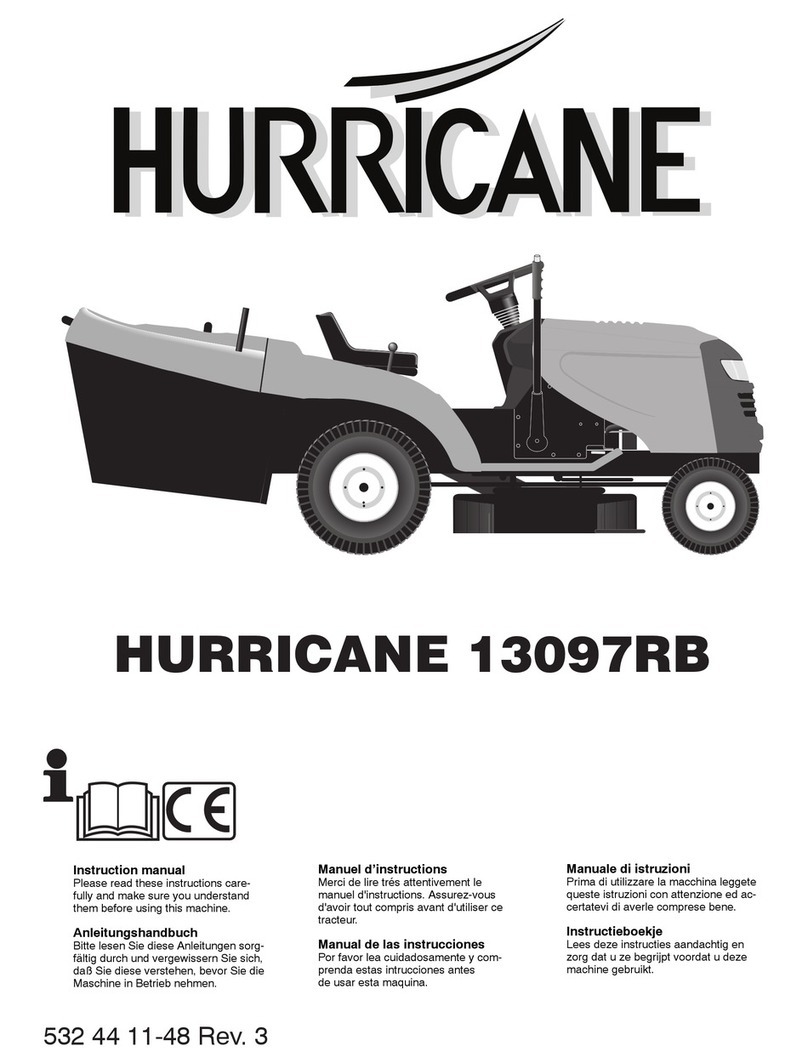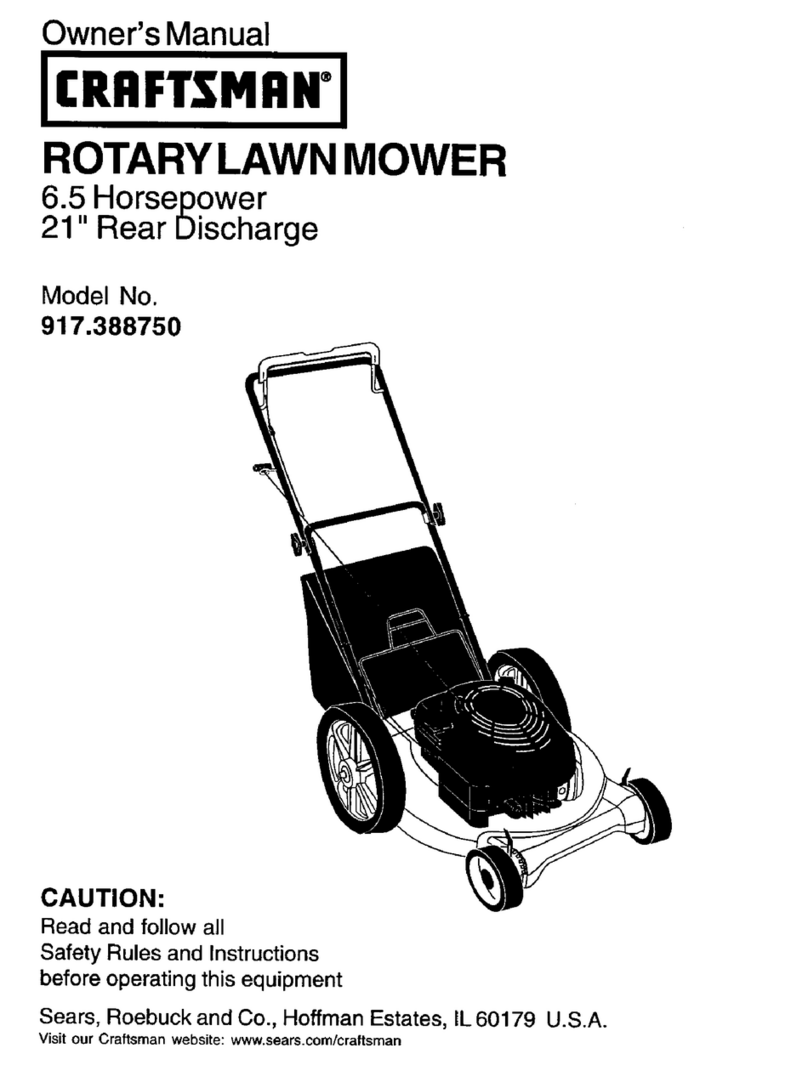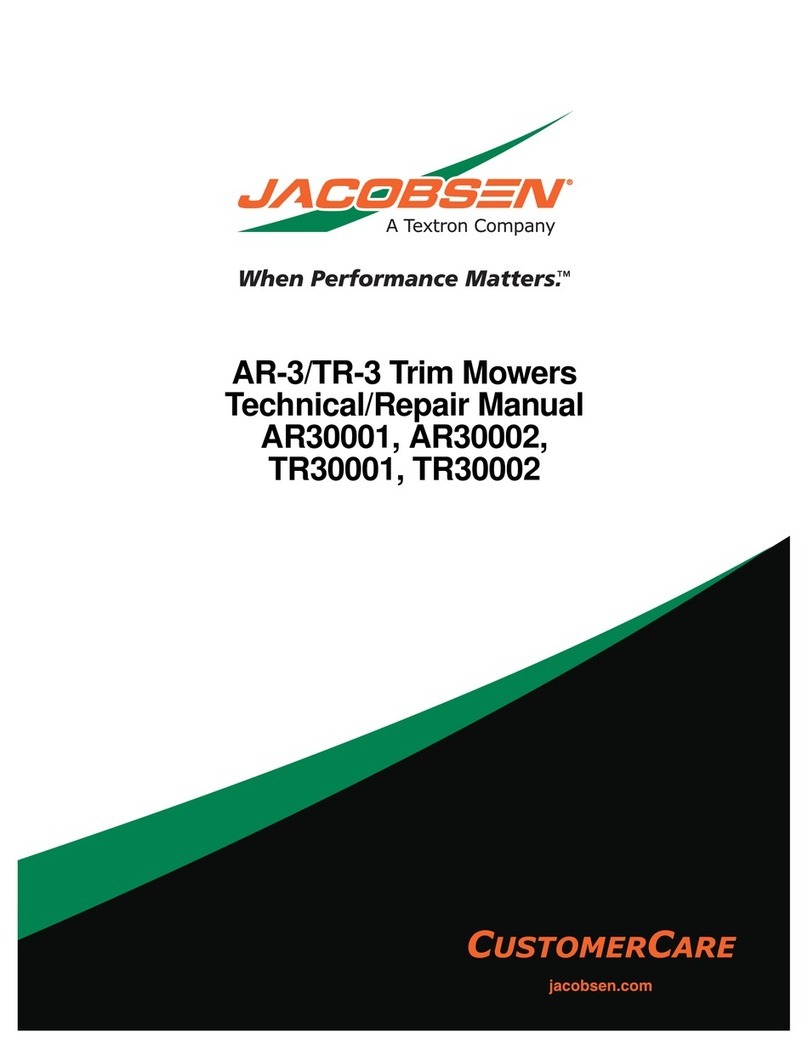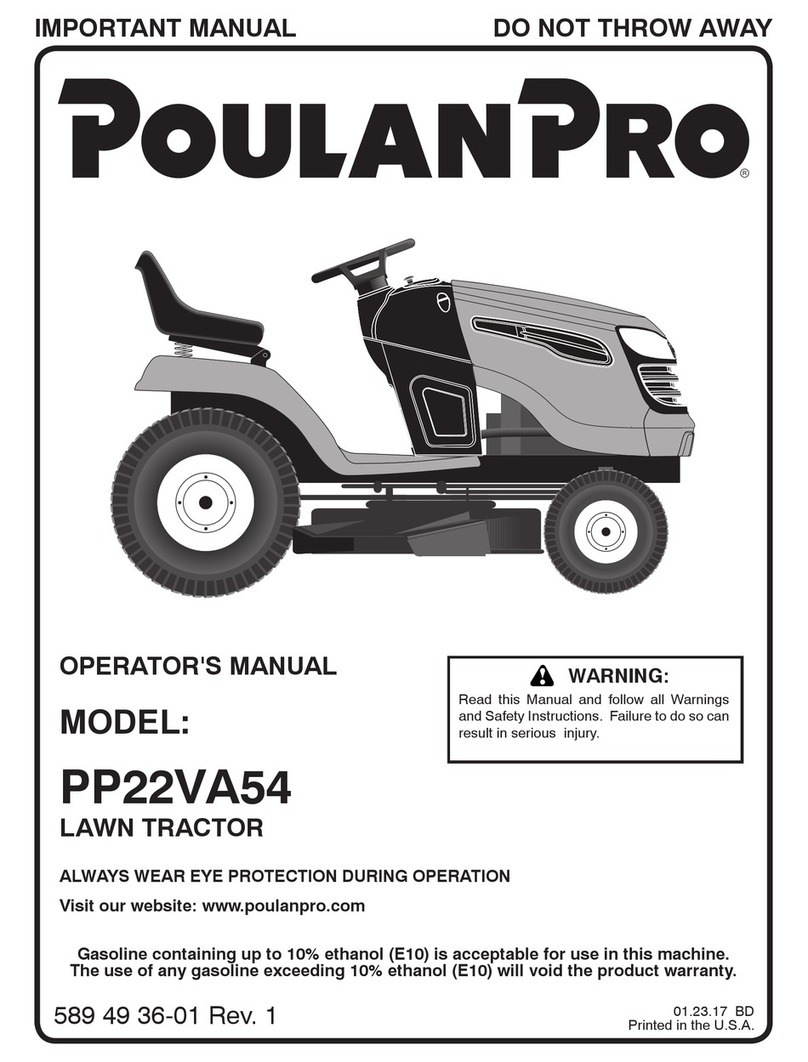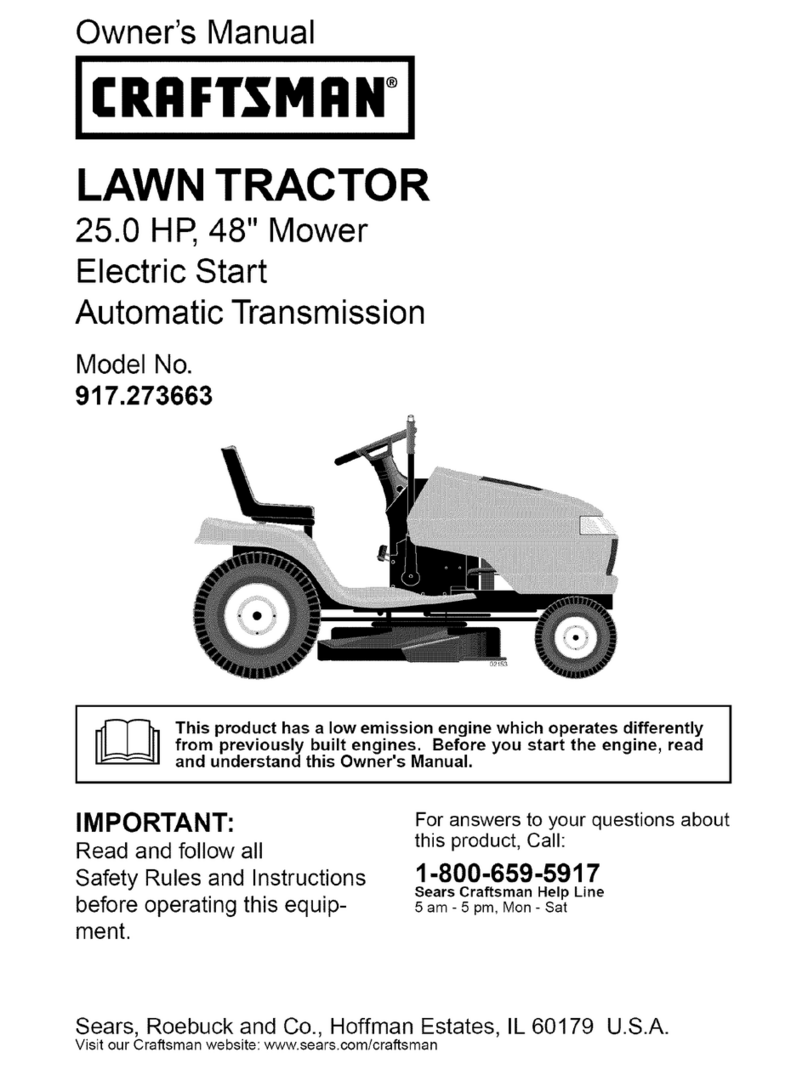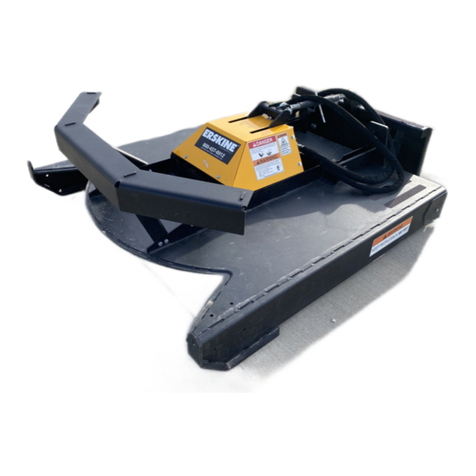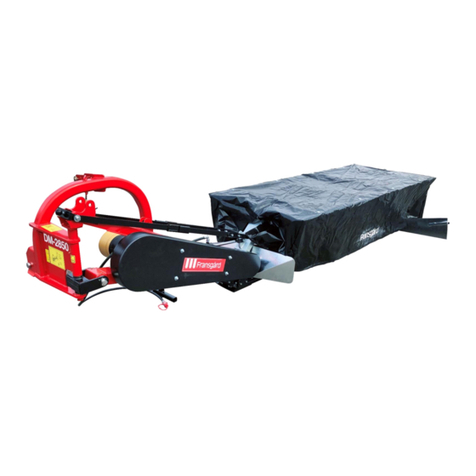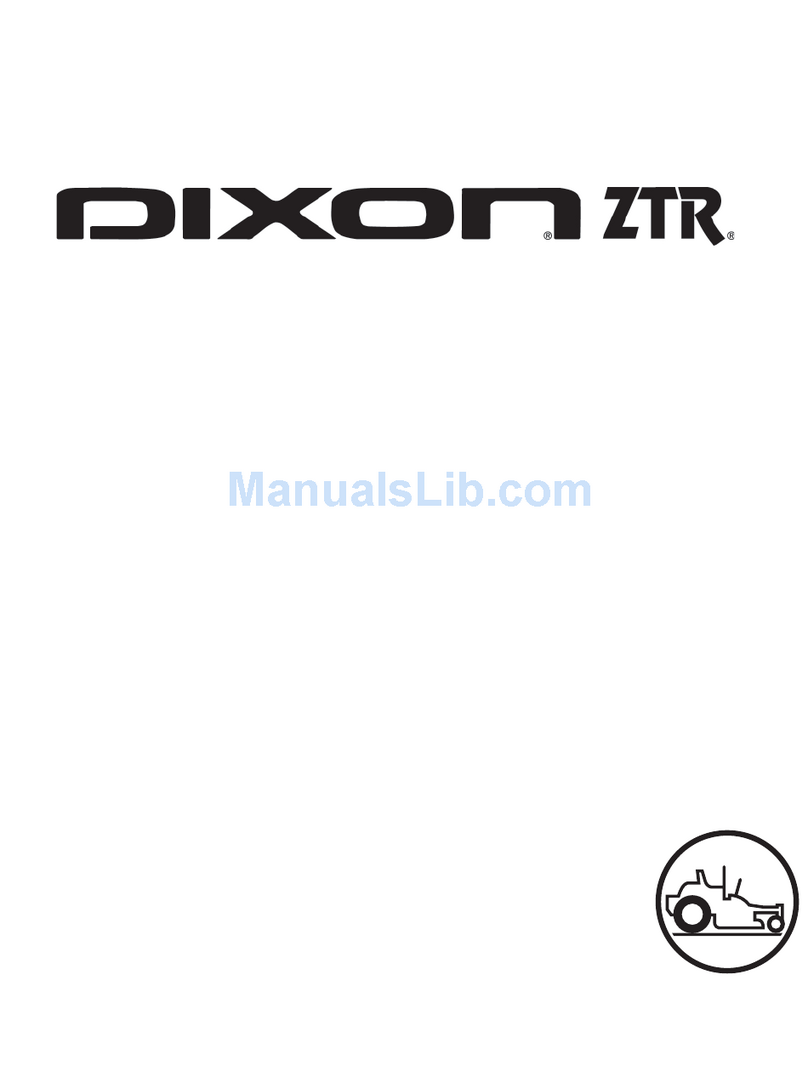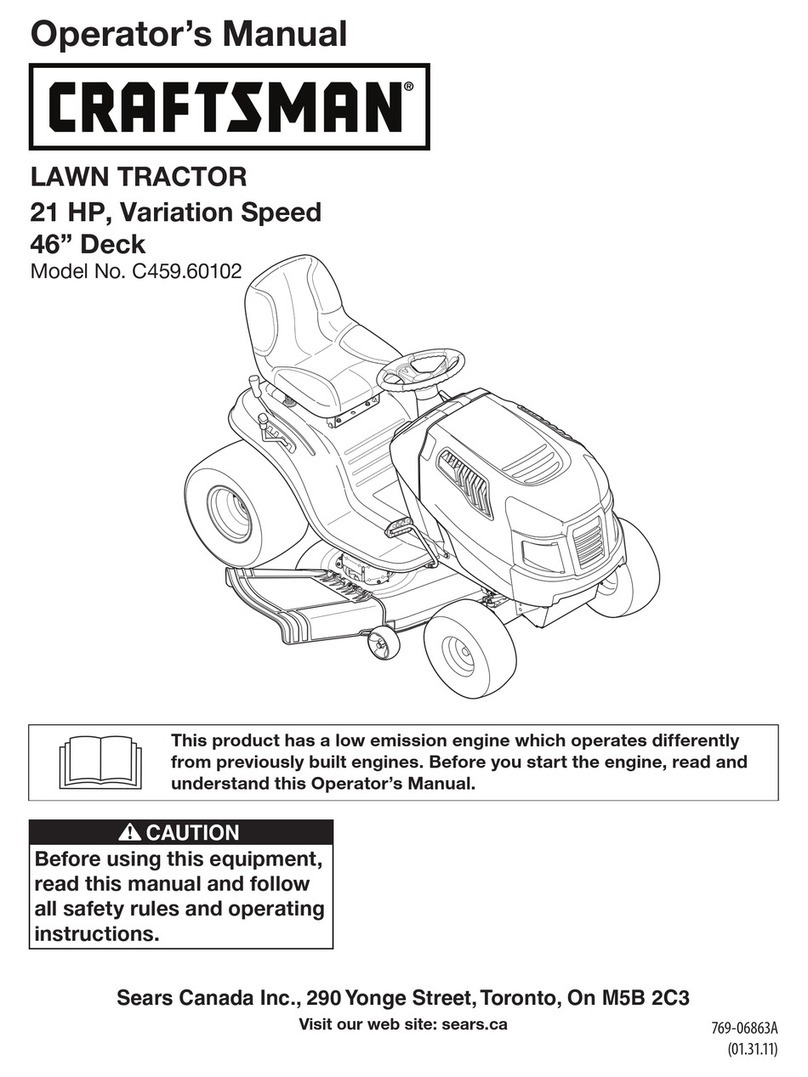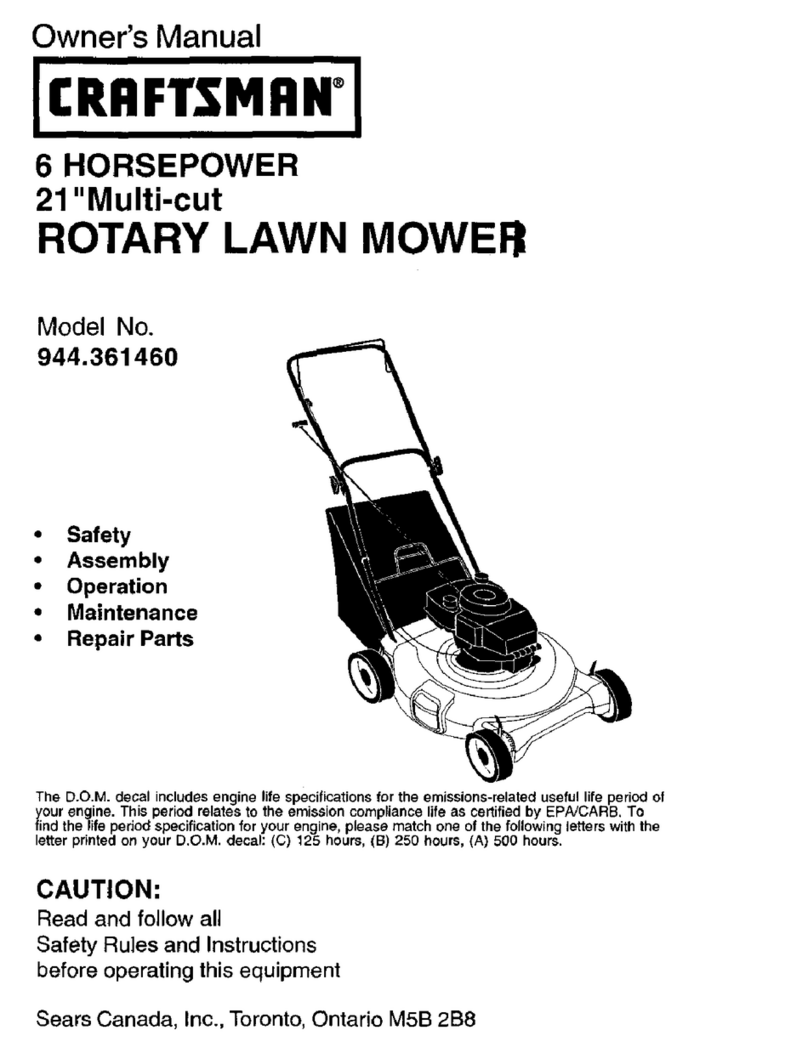FHM Value Leader EFGCH Series Application guide

Farmer-Helper EFGCH Flail Mower 1 Revision 10-14-17
Specificationssubjecttochangewithoutnotice.
Rugged Labor Saving Equipment Since 1995
www.Betstco.com
Toll Free: 877-876-7895, E-mail: [email protected]
83371 Melton Rd, Creswell OR 97426
Please read these instructions carefully before using!
You must fill with oil before operating!
Uses Approximately 3 quarts 80-90 gear lube
GREASE ALL FITTINGS BEFORE OPERATING!
FLAIL MOWER EFGCH
OPERATION & PARTS MANUAL
Save This Manual for Future Reference

Farmer-Helper EFGCH Flail Mower 2 Revision 10-14-17
Table of Contents
1. Introduction 3
2. Setup and Assembly Instructions 3
3. PTO Driveshaft Safety Tips 4
4. Protective Guards and Shields 5
5. Safety Instructions 5
6. Operator Protective Gear 6
7. Operation Checklist 6
8. Flail Mower Connection and Operation 6
9. Cutting Height Adjustment 8
10. Blade Replacement 9
11. Belt Tension and Adjustment 9
12. Lubrication Frequencies and Locations 9
13. Preventive Maintenance 10
14. Troubleshooting 10
15. Parts and Fasteners 11
16. Torque Values 12
17. Basic Parts Breakdown 13
18. Pictures 14
19. Flail Mower Specification 16
20. Parts Diagrams and Numbers 18
21. Warranty Registration 26

Farmer-Helper EFGCH Flail Mower 3 Revision 10-14-17
1. INTRODUCTION
Before using your flail mower, read and understand this operation manual and the
accompanying maintenance instructions. It contains important information which will
help you observe proper safety precautions, get the most work from your flail mower and
help prolong the life of your flail mower.
2. SETUP and ASSEMBLY INSTRUCTIONS
Your flail mower will arrive in a metal shipping frame. This frame can be dismantled to allow
access to all parts of your mower.
See torque value chart at end of manual for all specific bolts being used.
Remove parts box, PTO driveline, side cover shield, hydraulic side shift control
frame, and then mower from crate. See picture and verify parts, see picture at end of
manual.
Attach storage stand and PTO shield as shown in picture at end of manual.
Attach hydraulic offset control frame as shown in picture at end of manual. Metal
plates go on the underside of mower deck frame. Hint-Do not tighten nuts & bolts until
all have been loosely assembled in their proper location.
Attach upper 3pt bracket as shown in picture at end of manual. Hint-Do not tighten nuts
& bolts until all have been loosely assembled in their proper location. Tighten from top-
down.
Attach 3Pt. lift pins as shown in picture at end of manual.
Lube grease points on mower and driveline (4 total points, use lithium base general
purpose grease) see picture at end of manual
Before attaching side cover, check all axle bolts and pulley screws for tightness (see
picture at end of manual). Verify belt deflection is ¼ ” to ½ ” Attach side safety cover. 1
connecting bolt (see picture at end of manual).
Fill gear box with 80-90 gear oil (Approx. 1 Qt.) Fill to full plug level in gear box to the
left side of PTO shaft. See picture at end of manual for more info.
Attach hydraulic lines to a source for actuating a hydraulic cylinder.
Completely read the rest of manual before attaching PTO driveline and operating the
mower.
Before Operation check all bolts, nuts, and zerks for tightness. Verify the
tightness of all blade retaining bolts and nuts. Check all blades for free swinging action.

Farmer-Helper EFGCH Flail Mower 4 Revision 10-14-17
3. PTO DRIVESHAFT SAFETY TIPS
Your flail mower is shipped with a PTO driveshaft.
Always ensure that the PTO shaft is no more than 15 degrees of horizontal when
operating.
-The following steps are recommended for safe operation of the driveshaft under field
conditions.
-Test hitch angle to prevent the driveshaft from:
�
Extending beyond the recommended maximum length.
�
Bottoming out
�
Reaching a position that allows joints to lock
�
Exceeding the maximum allowable angle for constant velocity (CV) joints.
-Specify and test telescoping members to allow the lowest possible thrust loads,
considering the expected working conditions.
-Specify and test torque limiters to control excessive shock.
-Where necessary, specify and test overrun clutches to prevent inertial loads from
overpowering the tractor.
-Provide a means to support the drive shaft when it is disconnected from the tractor, to
prevent damage during storage or transportation.
-Provided drive shaft is of shear design using a grade 5 bolt, if replacing this bolt do not
use higher grade as this may cause damage to the PTO driveshaft, Implement, or your
tractor.
-On drive shafts with torque-limiting or overrun devices, be sure to connect the device on
the end of the drive shaft nearest the chipper.
-Provide a proper clearance zone for the operation of the driveshaft, to avoid damage to
the shielding components.
-It is not recommended to use PTO adaptors which may defeat the purpose of the
tractor’s master shield and/or adversely affect the performance of the driveshaft.

Farmer-Helper EFGCH Flail Mower 5 Revision 10-14-17
4. PROTECTIVE GUARDS AND SHIELDS
Do not allow the flail mower to be operated without the side cover or fender deflector’s
properly in place.
PTO driveshaft should consist of a PTO master shield, integral driveshaft shield, and a
mower input connection shield.
1. Follow all flail mower and tractor instruction labels and manuals. The flail mower
should be used only with the tractor’s PTO master shield in place.
2. Specify and test an integral driveshaft shield with end cones which will overlap, but
not interfere with the PTO master shield or flail mower input connection shield.
3. A flail mower input connection shield should be used in addition to the integral
driveshaft shield, in order to guard the shaft coupling and any torque limiting device
installed on the driveshaft.
4. Check that all routine maintenance of the driveshaft can be done without removal of
the shields.
5. SAFETY INSTRUCTIONS
Do not attempt to operate the flail mower until you have read and understood this manual.
Always keep guards and flail mower shields properly installed while operating the flail
mower.
Keep the decals in place and verify they are understandable. New labels can be ordered
from Betst Power Equipment upon request. If your flail mower is repainted, be sure the
labels and decals remain visible.
Never leave the flail mower running unattended.
Do not attempt alterations, repairs or adjustments while blade rotor is turning. Always
disconnect the PTO and stop the tractor motor, then put keys in your pocket.
Only use tractor of specified HP for your model flail mower as defined in the
specifications.
Keep hands, feet and other extremities out of and away from the blade rotor
area. When checking blades, EXERCISE EXTREME CAUTION! If
accidentally rotated, the blade rotor can contain enough residual energy to
cause serious injury.
Never allow anyone to stand beside or behind mower while operating.
Keep everyone,
especially children and animals, away from the operation area.
Anyone who has not read and understood this manual should not be in the area.

Farmer-Helper EFGCH Flail Mower 6 Revision 10-14-17
6. OPERATOR PROTECTIVE GEAR
The following protective clothing and gear is recommended when using your flail mower.
EYES -- Wraparound Safety Glasses or Goggles
EARS -- Ear Plugs
HANDS -- Leather Gloves
FEET -- Steel-Toed Boots
LEGS -- Heavy Pants
ARMS -- Long-Sleeved Shirt
NO LOOSE CLOTHING SHOULD BE WORN AROUND THE FLAIL MOWER
7. OPERATION CHECKLIST
CAUTION : Look under flail mower before operating to be sure the blade area is clear.
Make sure that:
�
You have completed all steps of the assembly instructions
�
The PTO shaft doesn’t come apart or bottom out during the normal lifting range.
�
There in no person around mower.
�
Remove Tractor Drawbar
During and after operation, check the grass clippings or mulched limbs for size and
quality of cut. It may be necessary to adjust the cutting height. See adjusting cutting
height.
8. Flail Mower Connection and Operation
Remember that if flail mower blades are blunted they will not cut properly. Dirt, rocks,
nails, or other foreign material will shorten blade life.
Always review the manual before operating the flail mower.
Operate mower in a safe well known area with the rear pointed away from doorways,
sidewalks, or any areas where your view is obstructed or people may approach.
Only use 540 RPM PTO Selection, any other use will void the warranty and may cause
severe damage to the gear box or mower.

Farmer-Helper EFGCH Flail Mower 7 Revision 10-14-17
Connecting to Tractor
Make sure there are no obstructions under the flail mower
Align lower link arms of tractor to hitch clevises on mower, Insert lower hitch pins into
lower ball swivels and attach linch pins.
Attach tractor top link to upper floating hitch on mower with pin supplied. Secure with
lock pin.
Slide driveline end with shear system over the tractor’s splined PTO shaft and secure it
with locking device of driveline
Slide driveline end with twist system over the mower’s splined PTO shaft and secure it
with locking device of driveline.
Driveline should now be moved back and forth to ensure that it is secure on the PTO shaft
of the tractor and mower gearbox.
When raising the mower to the transport position, be sure that driveline does not contact
tractor or mower. Adjust and set the tractor’s 3-point hitch lift height so that the driveline
does not contact mower deck in the fully raised position.
When moving over paved or rock road way be sure mower is lifted off the surface.
To Begin Mowing
Clear the area to be mowed of objects and debris that might be picked up and thrown by
the mower blades.
Grass is best cut when dry. Mowing wet grass can cause plugging resulting in grass
clumps behind the mower.
Grass should be cut frequently as smaller clippings deteriorate faster.
If cutting extremely tall grass, it is best to raise the cutting height and mow the area, then
lower the cutting height and mow a second time at the desired height.
To begin cutting, observe all safety guidelines in the manual.
Always check Gear Oil Level before mowing
.

Farmer-Helper EFGCH Flail Mower 8 Revision 10-14-17
At low engine rpm’s you may experience jerking in the mower, increase the engine rpm until there
is no jerking.
Most cutting is preformed with the 3pt lift system in the float position.
If the blades are touching the surface while in float position, either adjust cutting height or raise
mower with 3pt lift into fixed height position. See cutting height adjustment.
At first begin mowing at a slow forward speed. Mower knives will cut better at a faster blades speed
and slower travel speed.
After mowing 50 feet, stop and check to see that the mower is adjusted properly for the cutting
conditions.
Do Not make sharp turns or attempt to back up while the mower is on the ground.
Do Not engage PTO with mower fully raised off the ground.
Normal mowing speed will be between 2-5 mph and you will need to maintain tractor PTO speed to
produce a clean cut so select a tractor gear and range that will maintain this combination. The
quality of cut or degree of debris pulverization will be better at lower ground speeds and cutting
denser ground cover or heavier brush may create the need to slow down. Remember to look back
often.
7. CUTTING HEIGHT ADJUSTMENT
The flail mower cutting height depends upon the height of roller, height of adjustable skids, and
length of top center link. See pictures at end of manual.
On uneven terrain the roller and skids should both be touching the surface of cutting area.
On even terrain the roller only needs to be touching the cutting surface.
On rough and rocky terrain it is recommend that you cut high with all parts of the mower 3” above
the ground. To achieve lowest cutting height in this type of terrain, raise roller and skids so mower
can be operated with 3 pt in fixed position, remember change in elevation may require you to adjust
cutting height to ensure blades do not make contact with the surface.
To adjust height of roller or skids, remove bolts and nuts that affix them, lift or lower both sides in
equal measurements, replace bolts and re-tighten. See picture at end of manual.
The top center link can also be used to adjust cutting height and aggressiveness of blades. In level
grass areas the top link should be adjust so the mower sits on a slightly lifted horizontal plane. In
dense or rough terrain the mower should sit in a slightly higher horizontal plane.

Farmer-Helper EFGCH Flail Mower 9 Revision 10-14-17
8. BLADE REPLACEMENT
The best way to tell if the blades need replacing is to watch the results of your mowing.
Dull blades cause many problems, including:
�
Loss of cutting power
�
Jamming or Plugging
�
Rough cutting with more vibration than usual
�
Rowing left in cut
To remove the blades, take the PTO shaft out of gear. Shut off the tractor and keep the
keys in your pocket.
The blades are accessed underneath the mower.
Prop up mower with suitable devise to hold the weight of the mower.
Inspect and remove/replace dull or missing blades.
9. BELT TENSION ADJUSTMENT
To adjust belt tension, take the PTO shaft out of gear. Shut off the tractor and keep the
keys in your pocket.
The belts are accessed behind black side cover.
Prop up mower with suitable devise to hold the weight of the mower.
Check the deflection of belts, should be between ¼ ”and ½ ”
To adjust tension, loosen bolts and nuts as shown in picture at end of manual.
Then using support move gearbox and shaft horizontally to adjust tension, then adjust
support bolt and lock nut to the adjusted height, see picture at end of manual.
Tighten all bolts and nuts that were loosed to adjust the tension.
10. LUBRICATION FREQUENCIES AND LOCATIONS
PTO SHAFT – 2 zerks on universal once a day with lithium based multipurpose grease.
ROTOR DRIVESHAFT – There is a zerk on each end of rotor shaft. Add multipurpose
grease before each use. (2-3 Pumps)
GEAR BOX – Check level each time before operating, drain/fill as needed.
HYDRAULIC OFFSET ROD – Apply lithium grease to sliding shafts.

Farmer-Helper EFGCH Flail Mower 10 Revision 10-14-17
11. PREVENTIVE MAITNANCE
Check all bolts & nuts after initial 4 hours of operation, and once per day thereafter
before beginning operation.
Check belt tension 4 hours after initial operation, and every 24 hours of operation
thereafter before beginning operation.
12.TROUBLESHOOTING
PROBLEM:
Belt Slipping
Possible Causes Solution
Rotor Shaft Area Clogged Unplug and clean mower deck.
Pulley Sheaves Clogged/Dirty Remove shield and clean sheaves
Belt Tension insufficient Check and adjust belt tension
Travelling to fast Reduce Travel Speed
Belt Worn Replace Belt
Blades Dull
Deck too flat Reverse/Replace
PROBLEM:
Patches of Uncut Grass
Possible Causes Solution
Low Throttle Increase Engine RPM
Travelling to fast Reduce Travel Speed
Blades Dull Reverse/Replace
PROBLEM:
Excessive Vibration
Possible Causes Solution
Missing Blades Replace missing blades
Worn Drive Belt Replace worn belt
Pulley Miss-Aligned/Damaged Re-Align/Replace
Debris in Belt Area Remove cover and clean area
PTO Driveline Bent Replace Bent/Broken Parts
Engine Speed Increase Engine Speed
PROBLEM:
Gear Box Noisy
Possible Causes Solution
Low Oil Level Check and Fill with Oil

Farmer-Helper EFGCH Flail Mower 11 Revision 10-14-17
PROBLEM:
Knives Scalping Grass
Possible Causes Solution
Incorrect Cutting Height Adjust Cutting height
Mowing Pattern Change Mowing Pattern
Turning to Quickly Reduce Speed during turns
PROBLEM:
Uneven Cut
Possible Causes Solution
Missing/Dull Blades Remove/Replace Blades
Travelling to Fast Reduce Travel Speed
Mower Not Level Adjust 3Pt Linkage
PROBLEM:
Tractor Loaded Down by Mower
Possible Causes Solution
Low Engine Speed Increase Engine Throttle
Travelling to Fast Reduce Travel Speed
Blade Area Clogged Clean Blade Area
13. PARTS AND FASTENERS
Your flail mower is designed for ease of maintenance. Replacement parts are available
from Betst Power Equipment at 1-877-876-7895 or Support@Betstco.com Check the
parts list for specification.
See Parts Diagrams at end of manual

Farmer-Helper EFGCH Flail Mower 12 Revision 10-14-17
Torque Values Chart
Bolt Head Identification Bolt Head Identification
5.8 8.8 10.9
Grade 2 Grade 5 Grade 8 Class 5.8 Class 8.8 Class 10.9
in-tpi 1 N · m ft-lb 3N · m ft-lb N · m ft-lb mm x pitch N · m ft-lb N · m ft-lb N · m ft-lb
1/4" - 20 7.4 5.6 11 8 16 12 M 5 X 0.8 4 3 6 5 9 7
1/4" - 28 8.5 6 13 10 18 14 M 6 X 1 7 5 11 8 15 11
5/16" - 18 15 11 24 17 33 25 M 8 X 1.25 17 12 26 19 36 27
5/16" - 24 17 13 26 19 37 27 M 8 X 1 18 13 28 21 39 29
3/8" - 16 27 20 42 31 59 44 M10 X 1.5 33 24 52 39 72 53
3/8" - 24 31 22 47 35 67 49 M10 X 0.75 39 29 61 45 85 62
7/16" - 14 43 32 67 49 95 70 M12 X 1.75 58 42 91 67 125 93
7/16" - 20 49 36 75 55 105 78 M12 X 1.5 60 44 95 70 130 97
1/2" - 13 66 49 105 76 145 105 M12 X 1 90 66 105 77 145 105
1/2" - 20 75 55 115 85 165 120 M14 X 2 92 68 145 105 200 150
9/16" - 12 95 70 150 110 210 155 M14 X 1.5 99 73 155 115 l215 160
9/16" - 18 105 79 165 120 235 170 M16 X 2 145 105 225 165 315 230
5/8" - 11 130 97 205 150 285 210 M16 X 1.5 155 115 240 180 335 245
5/8" - 18 150 110 230 170 325 240 M18 X 2.5 195 145 310 230 405 300
3/4" - 10 235 170 360 265 510 375 M18 X 1.5 220 165 350 260 485 355
3/4" - 16 260 190 405 295 570 420 M20 X 2.5 280 205 440 325 610 450
7/8" - 9 225 165 585 430 820 605 M20 X 1.5 310 230 650 480 900 665
7/8" - 14 250 185 640 475 905 670 M24 X 3 480 355 760 560 1050 780
1" - 8 340 250 875 645 1230 910 M24 X 2 525 390 830 610 1150 845
1" - 12 370 275 955 705 1350 995 M30 X 3.5 960 705 1510 1120 2100 1550
1-1/8" - 7 480 355 1080 795 1750 1290 M30 X 2 1060 785 1680 1240 2320 1710
1 1/8" - 12 540 395 1210 890 1960 1440 M36 X 3.5 1730 1270 2650 1950 3660 2700
1 1/4" - 7 680 500 1520 1120 2460 1820 M36 X 2 1880 1380 2960 2190 4100 3220
1 1/4" - 12 750 555 1680 1240 2730 2010
1
in-tpi = nominal thread diameter in inches-threads per in.
1 3/8" - 6 890 655 1990 1470 3230 2380
2
N· m = newton-meters
1 3/8" - 12 1010 745 2270 1670 3680 2710
3
ft-lb= foot pounds
1 1/2" - 6 1180 870 2640 1950 4290 3160
4
mm x pitch = nominal thread diameter in millimeters x thread
1 1/2" - 12 1330 980 2970 2190 4820 3560 pitch

Farmer-Helper EFGCH Flail Mower 13 Revision 10-14-17
1. Blade axle 2. Mower Housing 3. Combined Safety Fender
4. Support Leg 5. Gearbox Assembly 6. 3Pt Bracket
7. Transmission shaft 8. Pulleys and Belts

Farmer-Helper EFGCH Flail Mower 14 Revision 10-14-17
Parts Box Includes the following show
in picture, you may receive extra parts
that are not shown in the picture.
Attach Hydraulic
Offset Frame, 3Pt
Bracket, Storage
Stand, and PTO
Shield shown in
picture
Lubrication Point on Lower Axle and Pulley Detail Picture

Farmer-Helper EFGCH Flail Mower 15 Revision 10-14-17
15
Fill Gear Box until oil comes out
plug on left side of PTO shaft
Next Fill Tube from Gear
Box to Belt Cover
Or
Grease Bearing at end of
Tube.
Bearings can take a lot of
Grease.
Roller and Skid Height Adjustment
Belt Tension Adjusting Points

Farmer-Helper EFGCH Flail Mower 16 Revision 10-14-17

Farmer-Helper EFGCH Flail Mower 17 Revision 10-14-17
SafetyLabels
Your Flail Mower comes equipped with all safety labels in place. They were designed
to help you safely operate your implement. Read and follow their directions.
r
1. Keep all safety labels clean and legible.
2. Replace all damaged or missing labels. To order new labels contact Betst Products.
r
3. Some new equipment installed during repair requires safety labels to be affixed to the
Replaced component assembly
4. Refer to this section for proper label placement.
To install new labels:
A. Clean the area where the label is to be placed.
B. Spray soapy water on the surface where the label is to be placed.
C. Peel backing from label. Press firmly onto the surface.
D. Squeeze out air bubbles with the edge of a credit card.
A

Farmer-Helper EFGCH Flail Mower 18 Revision 10-14-17
B
C

Farmer-Helper EFGCH Flail Mower 19 Revision 10-14-17
D
E

Farmer-Helper EFGCH Flail Mower 20 Revision 10-14-17
This manual suits for next models
5
Table of contents


